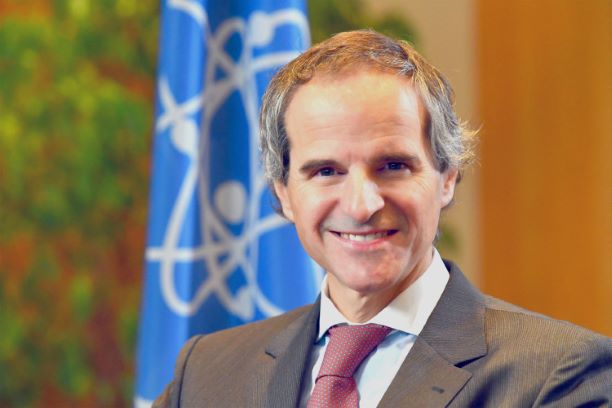
By Cyber Era NG Special Correspondent
The nuclear safety and security situation at Ukraine’s Zaporizhzhya Nuclear Power Plant (ZNPP) remains extremely fragile with “very real” potential dangers of a major accident, Director General Rafael Mariano Grossi of the International Atomic Energy Agency (IAEA) told the United Nations Security Council ahead of his fourth mission to the site early next month.
Addressing the Security Council on Thursday for the sixth time since the war began almost two years ago, he warned against complacency and made clear the IAEA would stay focused on helping to prevent a potentially catastrophic nuclear accident, at the ZNPP or any of the country’s other nuclear facilities.
“A nuclear accident has not yet happened. This is true. But complacency could still lead us to tragedy. That should not happen. We must do everything in our power to minimize the risk that it does,” he said.
Briefing the 15-member Security Council on developments since the establishment last May of the five concrete principles for the protection of Europe’s largest nuclear power plant, he emphasised the importance of his experts stationed at the site obtaining the access they need to monitor adherence to these principles.
Mr. Grossi announced he would cross the frontline to travel to the ZNPP “within the next two weeks”, enabling him to assess the situation there first-hand some eight months after his previous mission to the plant.
The last time he went to the site in southern Ukraine was in June 2023, soon after the destruction of the downstream Kakhovka dam, which supplied water for reactor cooling and other essential nuclear safety and security functions at the ZNPP.
In his address to the Security Council at UN Headquarters in New York, the IAEA Director General underlined potential threats to nuclear safety and security at the site, as well as other challenges.
“Although the plant has not been shelled for a considerable time, significant military activities continue in the region and sometimes in the vicinity of the facility, with our staff reporting rockets flying overhead close to the plant, thereby putting at risk the physical integrity of the plant,” he said.
In addition, the plant’s off-site power supplies remain “highly precarious”, as it is currently relying on just two external power lines, compared with 10 before the conflict.
“There have now been eight occasions when the site lost all off-site power and had to rely on emergency diesel generators, the last line of defence against a nuclear accident, to provide essential cooling of the reactor and spent fuel,” Grossi said.
He also highlighted challenges related to the significantly reduced number of staff – who are “under unprecedented psychological pressure” – as well as the equipment maintenance situation.
“The reduced number of qualified and trained operating personnel and the challenging supply chain has had a negative impact on the maintenance of equipment which is essential for maintaining the safety of the plant,” he said.
Grossi stressed that the IAEA experts should have sufficient access to monitor the situation regarding the seven pillars for ensuring nuclear safety and security during an armed conflict, as well as the more recent five protection principles for the ZNPP.
“There are occasions when the team has not had timely access to some areas of the plant – sometimes for many months,” he said.
There “have been no indications that the five concrete principles are not being observed,” he said, but added: “Nevertheless, in line with the evolving situation, the Agency needs to have timely access to all areas of the ZNPP of significance for nuclear safety and security, to monitor that all five concrete principles are being observed at all times.”
On the ground at the ZNPP this week, the IAEA experts at the plant were informed that one of the plant’s back-up power electrical transformers that failed last week was under maintenance and that there were no indications of structural damage.
The failure showed the continuing vulnerability in the availability of external power, which the plant needs to cool its six reactors and for other essential nuclear safety and security functions.
The ZNPP said it had investigated and identified the preliminary cause of the failure, and the IAEA experts are expecting to be informed of the outcome in the near future.
Also this week, the IAEA experts performed a walkdown of the cooling pond area and met with plant staff handling the site’s water management to discuss how the cold winter weather may affect the cooling pond, which supplies water for some of the site’s needs not related to safety, and how the ZNPP deals with any impact of ice.
Prior to the conflict, the water in the cooling pond was kept warm due to the operation of the reactor units. With all six units now in extended shutdown, the IAEA team observed small amounts of ice in a few locations of the cooling pond.
But earlier this winter, when it was colder, most of the cooling pond surface was covered by a two-centimetre layer of ice, the site informed the IAEA team.
Despite the winter cold, the team was also informed that there are a lot of fish in the cooling pond. Several non-tropical fish species have survived the cold temperatures and continue to clean the cooling pond water.
The height of the cooling pond currently is at 15.61 metres, around one metre below the level before the Kakhovka dam was destroyed with little change in the height over recent months.
The cooling water for the six shutdown reactors continues to be supplied by the 11 groundwater wells near the sprinkler ponds.
The IAEA experts were not permitted to visit the ZNPP cooling pond isolation gate during the walkdown.
During other walkdowns in the past week, the IAEA experts visited the reactor hall of unit 3, as well as the safety systems rooms of units 3 and 5. A single small boric acid deposit was observed in one of the safety systems rooms of unit 3.
Regarding the boric acid deposits in unit 6, the Russian Federation regulatory body issued a “special order” on 20 January for the repair of the leak in the unit’s storage tank. The ZNPP informed the IAEA experts of its intention to fix the microcracks in the tank, which will require its draining. Borated water is used in the primary coolant to help maintain nuclear safety functions.
The IAEA team also conducted a walkdown of the 750 kilovolt (kV) open switchyard where it confirmed that only one such power line was connected to the electricity grid – down from four before the conflict. The switchyard components that were damaged in 2022 had been dismantled, but spare parts were available.
Elsewhere in Ukraine, the IAEA experts present at the Khmelnitsky, Rivne and South Ukraine Nuclear Power Plants (NPPs) as well as at the Chornobyl site have reported that nuclear safety and security is being maintained despite the challenging war-time circumstances, including the frequent sound of air raid alarms at some of the facilities. On 23 January, a new team of experts arrived at the Chornobyl site, replacing their colleagues there.
In his address to the Security Council, Director General Grossi noted that these NPPs were operating, with most of their reactor units at full capacity.
“Although our teams continue to report that nuclear safety and security is maintained, they are also confirming the looming threat of military conflict and at some plants having to take shelter on several occasions. I wish to remind the Council that the availability of off-site power is essential to ensure their safe operation,” he said.



